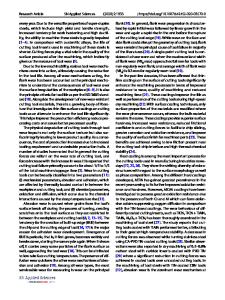Formation of Chromium Nitride and Intragranular Austenite in a Super Duplex Stainless Steel
- PDF / 1,965,063 Bytes
- 8 Pages / 593.972 x 792 pts Page_size
- 64 Downloads / 371 Views
DUCTION
DUPLEX stainless steels, consisting of ferrite and austenite, possess a unique combination of high corrosion resistance in combination with high mechanical strength. The properties are influenced by the balance of the two constituent phases, and duplex stainless steels are generally solution heat treated to generate a fine-grained microstructure of 50 pct ferrite and 50 pct austenite. However, during welding, this fine-grained and balanced microstructure is degenerated, and a new microstructure is formed through a dynamic interplay between the ferrite and the austenite with change in temperature. At temperatures close to solidus, the duplex microstructure transforms into single-phase ferrite which rapidly coarsens.[1,2] During cooling, the austenite forms as Widmansta¨tten structure or grain
N. HOLLA¨NDER PETTERSSON is with the Swerim AB, Isafjordsgatan 28A, 164 40 Stockholm, Sweden and also with the Department of Materials Science, KTH Royal Institute of Technology, Brinellva¨gen 23, 114 28 Stockholm, Sweden. Contact e-mail: [email protected] D. LINDELL and F. LINDBERG are with the Swerim AB. A. BORGENSTAM is with the Department of Materials Science, KTH Royal Institute of Technology. Manuscript submitted May 17, 2019.
METALLURGICAL AND MATERIALS TRANSACTIONS A
boundary allotriomorphs, and the weldability is significantly improved by alloying with nitrogen that acts as a strong austenite former and increases austenite transformation kinetics.[3–5] Too slow cooling can promote precipitation of intermetallic phases (v and r) and Cr2N in grain or phase boundaries in the critical temperature range 1273 K down to 973 K.[6–9] A rapid cooling (or quenching), on the other hand, will generate a high density of chromium nitrides in the interior of the ferrite grains as a result of supersaturation with respect to nitrogen.[10–14] In multipass welding, this microstructure of supersaturated ferrite grains, potentially with chromium nitrides, in the heat-affected zone (HAZ) becomes repetitively heat treated due to heat transfer from subsequent passes. It is not only important to understand the precipitation that occurs during quenching but also the transformations during an additional heat treatment to control the properties. It has been reported that in addition to trigonal Cr2N, also CrN with a cubic halite-type structure is formed upon rapid quenching of duplex stainless steels.[3,11–13] CrN is often seen as plates surrounding the Cr2N particles; however, the reason to this is not yet fully understood. It is further known that a second heat treatment promotes the formation of secondary austenite (designated c2) that grows on the preexisting
austenite grains,[15,16] or by formation of intragranular idiomorphs in the ferrite.[15,17] Ramirez et al.[15,18] suggested that the formation of intragranular austenite could be related to chromium nitrides; however, this mechanism was never confirmed. This is important to understand since the nitrides and intragranular austenite are prone to form in duplex stainless steel welds, and i
Data Loading...











